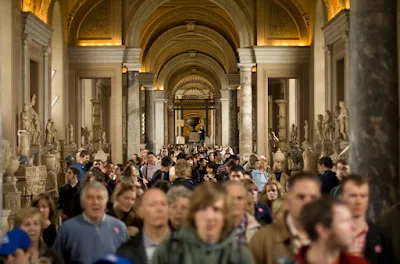The Vatican Museums are Christian and art museums located within the city boundaries of the Vatican City. They display works from the immense collection amassed by Popes throughout the centuries including some of the most renowned classical sculptures and most important masterpieces of Renaissance art in the world. The museums contain roughly 70,000 works, of which 20,000 are on display, and currently employ 640 people who work in 40 different administrative, scholarly, and restoration departments.
Pope Julius II founded the museums in the early 16th century. The Sistine Chapel, with its ceiling decorated by Michelangelo and the Stanze di Raffaello decorated by Raphael, are on the visitor route through the Vatican Museums. In 2013, they were visited by 6 million people, which combined makes it the 6th most visited art museum in the world.
There are 54 galleries, or sale, in total, with the Sistine Chapel, notably, being the very last sala within the Museum. It is one of the largest museums in the world. In 2017, the Museum's official website and social media presence was completely redone, in accord with current standards and appearances for modern websites
Pope Julius II founded the museums in the early 16th century. The Sistine Chapel, with its ceiling decorated by Michelangelo and the Stanze di Raffaello decorated by Raphael, are on the visitor route through the Vatican Museums. In 2013, they were visited by 6 million people, which combined makes it the 6th most visited art museum in the world.
There are 54 galleries, or sale, in total, with the Sistine Chapel, notably, being the very last sala within the Museum. It is one of the largest museums in the world. In 2017, the Museum's official website and social media presence was completely redone, in accord with current standards and appearances for modern websites
The Vatican Museums trace their origin to one marble sculpture, purchased 500 years ago: the sculpture of Laocoön and his Sons was discovered 14 January 1506, in a vineyard near the basilica of Santa Maria Maggiore in Rome. Pope Julius II sent Giuliano da Sangallo and Michelangelo Buonarroti, who were working at the Vatican, to examine the discovery. On their recommendation, the pope immediately purchased the sculpture from the vineyard owner. The pope put the sculpture of Laocoön and his sons on public display at the Vatican exactly one month after its discovery.
Benedict XIV founded the Museum Christianum, and some of the Vatican collections formed the Lateran Museum, which Pius IX founded by decree in 1854. The Museums celebrated their 500th anniversary in October 2006 by permanently opening the excavations of a Vatican Hill necropolis to the public. On 1 January 2017, Barbara Jatta became the Director of the Vatican Museums, replacing Antonio Paolucci who had been director since 2007.
The art gallery was housed in the Borgia Apartment until Pope Pius XI ordered construction of a proper building. The new building, designed by Luca Beltrami, was inaugurated on 27 October 1932. The museum has paintings including :
- Giotto's Stefaneschi Triptych
- Olivuccio di Ciccarello, Opere di Misericordia
- Raphael's Madonna of Foligno, Oddi Altarpiece and Transfiguration
- Leonardo da Vinci's St. Jerome in the Wilderness
- Caravaggio's Entombment
- Perugino's Madonna and Child with Saints and San Francesco al Prato Resurrection
- Filippo Lippi's Marsuppini Coronation
- Jan Matejko's Sobieski at Vienna
Other Highlights in the Museum:
- The red marble papal throne, formerly in the Basilica di San Giovanni in Laterano.
- Roman sculpture, tombstones, and inscriptions, including the Early Christian Sarcophagus of Junius Bassus and Dogmatic sarcophagus, and the epitaph of Lucius Cornelius Scipio Barbatus.
- The Raphael Rooms with many works by Raphael and his workshop, including the masterpiece The School of Athens.
- The Niccoline Chapel.
- The Sistine Chapel, including the Sistine Chapel ceiling.
- The Gallery of Maps: topographical maps of the whole of Italy, painted on the walls by friar Ignazio Danti of Perugia, commissioned by Pope Gregory XIII (1572–1585). It remains the world's largest pictorial geographical study.
- The frescoes and other works in the Borgia Apartment built for Pope Alexander VI (Borgia).
- The double spiral staircase, designed by Giuseppe Momo in 1932. The staircase has two parts, a double helix, and is of shallow incline, being a stepped ramp rather than a true staircase. It is encircles the outer wall of a stairwell of approximately fifteen meters (49 feet) wide and with a clear space at the center. The balustrade around the ramp is of ornately worked metal
On the last Sunday of each month, the Vatican Museum is open to the public for free. It is popular and common for people to wait in line for many hours. The other days of the week you can use the online ticket office to purchase an individual ticket or group tour ticket, either of which will enable you to bypass the ticket line completely.
For More Details - Officical Website Of Vatican Museum











No comments:
Post a Comment
Stay updated with our blog for more quality content! Your feedback is appreciated. Contact us at harshrex@outlook.com with any suggestions.